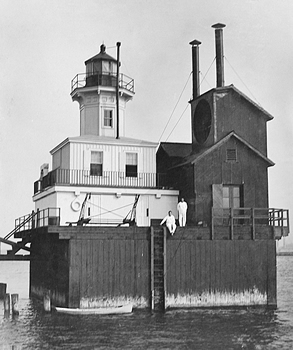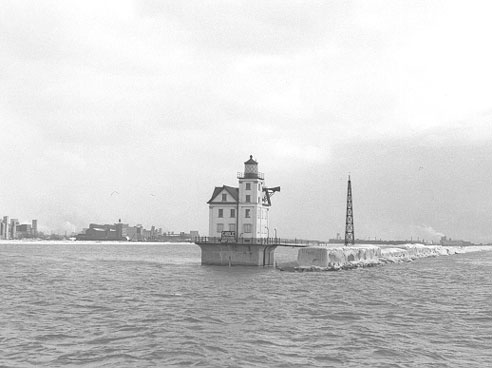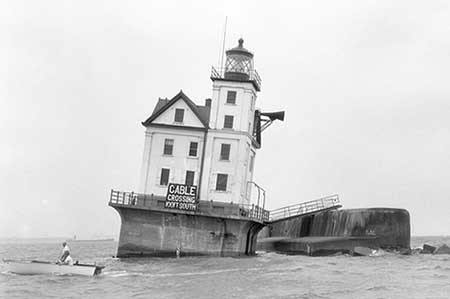Buffalo Breakwater Lighthouse
Buffalo, New York - 1961 (1872**)

History of the Buffalo Breakwater Lighthouse
Posted/Updated by Bryan Penberthy on 2014-10-13.
As Buffalo became an increasingly important port town, the harbor had to grow to handle the additional traffic. To mark the outer harbor, the Lighthouse Board authorized the construction of the Buffalo Breakwater, North End Lighthouse.
During the 1840s through the 1850s, more than a dozen grain elevators were built in the Buffalo Harbor. This helped fuel the city's growth in the latter half of the nineteenth century, bringing a massive influx of shipping traffic in the harbor.
To enlarge the harbor, construction of a 4,000-foot breakwater was started in 1868. On July 15, 1870, an appropriation of $30,000 was made for the construction of two lighthouses, one for each end of the new breakwater.
By 1871, as only 1750 feet of the breakwall was complete, construction was started on the North End Lighthouse. On May 18, a forty-foot-square timber crib was sunk twenty feet behind the breakwall. By June 24, the crib was finished, and work on the lighthouse started. As the breakwater would be difficult to reach at certain times of the year, the Lighthouse Board felt that the structure would need to be outfitted with quarters for the keepers.
The Annual Report of the Lighthouse Board for the year 1871 had the following detailed information:
On the west side of the beacon, twenty-four feet above the water, a Fog-bell will be arranged, striking three times in quick succession, at intervals of thirty seconds. The striking apparatus will occupy one of the rooms of the beacon. It is expected that this work will be completed by September 15, 1871. The Light will be of the fourth order, fixed, red, the focal plane thirty-seven feet above the level of the lake.
As the breakwater wasn't complete, a proposal called for placement of a temporary frame beacon with a focal plane of twenty-eight feet above lake level at the southern end. When completed, the plans called for a full lighthouse with a fourth-order lens displaying a fixed white light. As it would be several years before the breakwater would be completed, no appropriation was asked for at the time.
Work on the northern crib was suspended on September 9, 1871 due to irregularities in its settling. To stabilize the crib for the coming winter, several heavy stones were placed around the northwest corner to prevent it from being undermined, and several sheets of boiler iron were placed to protect the crib from ice damage.
Work resumed in the spring, and by July 10, the interior of the lighthouse was finished. The fog bell that was suspended from the west side of the lighthouse, was moved over from the Buffalo Main Lighthouse. Inside the lantern was a fourth-order Fresnel lens displaying a fixed red light in a 360° arc.
Although there was initial talk of a lighthouse to mark the southern end of the breakwater, no other mention of it exists within the Annual Reports of the Lighthouse Board past 1871, so it appears that the project was canceled.
 1872 Breakwater Lighthouse, circa 1910
1872 Breakwater Lighthouse, circa 1910
In 1880, there was mention of some repairs to the structure, and the entire station received a coat of paint. By 1888, three of the cluster piles protecting the northeast corner of the crib were replaced, and the station was listed in fair condition.
A year later, other rehabilitative work was done at the station. The Annual Report of the Lighthouse Board for that year had the following entry:
1045. Buffalo Breakwater, north end, Lake Erie, New York - The foundation and upright timbers supporting the fog-bell were replaced with new ones. The timber foundation supporting the dwelling and the platform around the dwelling were entirely renewed. A bell is used as a fog-signal at this light-station. It is ineffective. It is therefore suggested that it be replaced by a steam fog-signal at a cost not exceeding $4,300, and it is recommended that an appropriation of this amount be made therefor.
It appears that little traction was made on the fog signal as the same entry appeared in the report for 1891 and 1892. Finally, an act approved on August 5, 1892 provided the $4,300 requested. To make the necessary space for a new fog signal building on the crib, the dwelling and light tower were moved to the west corner of the crib.
A separate contract was made to construct the fog signal building. Inside the new building would be a boiler and machinery for a 10-inch steam whistle. Per the contract, the fog signal house was to be completed and ready for the machinery by August 15, 1893.
The new steam-powered fog signal was effective, and from the entry in the Annual Report of the Lighthouse Board for 1895, it appeared to work too well as it annoyed the people of Buffalo:
1098. Buffalo Breakwater, north end, Lake Erie, New York - Complaints having been made that this fog signal when in operation is an annoyance to the people of Buffalo, the characteristic was changed from two blasts of 3 seconds each during each minute, to one blast of 3 seconds each minute, and a reflector was erected upon the signal house and on the land side of the steam whistle. It is a concave structure constructed somewhat on the principle of a parabolic reflector, that it may collect and divert the sound waves from the city and toward the lake.
Complaints surfaced that the light from the tower was obscured, and in 1899, the tower was raised an additional 12 feet. This allowed for a watchroom to be established beneath the lantern. As the fog bell was left on the tower as a backup, the room that the clockwork occupied and the oil room were moved to an area beneath the dwelling, which was enclosed for that purpose. Finally, a new smokestack was provided for the fog signal boiler.
The fog signal boiler was discontinued on June 20, 1900 to install new equipment. New twin water-tube boilers were installed and ready for use on July 28, 1900. By 1902 several courses of decayed and defective timbers were replaced and all of the timbers supporting the keeper's dwelling were replaced.
Other work undertaken at this time included, the truss frame being boarded up to provide additional storage room, several sections of iron railing were installed, and the coal room for the steam signal was enlarged.
The Annual Report of the Lighthouse Board goes on to talk about the "mechanical ability and experience of high order" needed by the keepers to maintain the remote lightstation and how very little living space is allotted for each man. The yearly keeper's salary was $560 and the assistants was $450, without any dwelling provided for them.
The Lighthouse Board stated that "This is an important station, and should command the services of first-class men for keepers," and they were worried that they would have a hard time attracting those men with a low salary and not providing a dwelling.
The U.S. Government owned most of the land near the mouth of the Buffalo River, and the Lighthouse Board utilized most of it. On this land was the Buffalo Lighthouse Depot, which serviced most of the aids to navigation in the Tenth District, the slips for the lighthouse tenders to dock at, and the 1833 Buffalo Lighthouse, sometimes called the "old stone tower." Right next to the depot, was a U.S. Lifesaving Station, established in 1879.
Therefore, the entry in the annual report for 1902 recommended the construction of the double dwelling on shore, on government land near the south pier at a cost of $5,500. The Lighthouse Board suggested that this location would be convenient for the keepers as they must row to the station anyways and recommended that the appropriation be made.
Little progress in the dwelling was made, and the following year, the same request appeared in that annual report, however, due to increases in the cost of labor and materials, it was estimated that the cost of construction would now be $6,200. Again, the appropriation was asked for.
That same year, as there were now two distinct entrances to the Buffalo Harbor, two unique lighthouses were erected to mark the inlets. The new lights, known as "milk bottles," were established to mark the entrances. They were called the Buffalo North Breakwater Southside Lighthouse and the South Buffalo Northside Lighthouse.
Entries requesting funds for a new dwelling appeared in the Annual Report of the Lighthouse Board in 1904 and 1905. Finally, a bill was put before Congress asking for the construction of the lightkeeper's dwelling. A letter from the Department of Commerce and Labor to the House Committee on Interstate and Foreign Commerce dated December 21, 1905 stated that the department would recommend passage of the bill:
This Department has the honor to acknowledge the receipt of a letter dated December 14, 1905, from your committee inclosing a copy of H.R. 196, "to authorize the construction of a light-house keeper's dwelling at Buffalo Harbor, New York," on which suggestions are asked, touching the merits of the bill and the propriety of its passage.
In reply this Department begs leave to state that the Light-House Board, to which this matter was referred, reports that in its last four annual reports it recommends that an appropriation of $6,200 be made for this purpose, and that it is still of opinion that this appropriation should be made. This appropriation is also recommended on page 208 of the current Book of Estimates.
This Department concurs in these views of the Light-House Board and has the honor to recommend the passage of the bill in question.
Within two years, the Lighthouse Board was recommending the whole station be rebuilt. The following entry appeared in the Annual Report of the Lighthouse Board in 1908:
The crib occupied by the buildings of this station was built in 1872. The superstructure is greatly decayed and the fog-signal house situated thereon is settling. The keepers' quarters, from which the tower rises, are leaking and too much decayed for economical repair. The station is an important one, and there is urgent need for the early provision of funds for rebuilding. The Board recommends that an appropriation of $43,200 be made for doing the work specified.
As traffic in the Buffalo Harbor continued to build, problems arose. On numerous occasions, the Buffalo Breakwater Lighthouse was hit. A tug struck it in 1899, then a barge in 1900, a freighter in 1909 and on November 10, 1910, the Buffalo Breakwater Lighthouse was hit by the steamer Norseman.
Perhaps, these were omens of things to come.
Progress was finally made towards the rebuilding of the breakwater lighthouse when an act of March 4, 1911, appropriated $60,000 for the rebuilding of the station "on the present or an adjacent site." Plans and specifications were being drawn up, but as of June 30, 1911, no part of the appropriation was expended.
Before the new lighthouse could be constructed, the old breakwater lighthouse was demolished. The crib was taken down below lake level and a new concrete crib was constructed upon it.
By June 30, 1912, the Lighthouse Board had entered into a contract to have the station built, and was roughly 10% complete. The contract had stipulated that the work be completed by April 22, 1913, but that did not happen. The station was mostly complete as of April 1914, however, the new diaphone fog-signal was installed in July.
 The 1914 Buffalo Breakwater Lighthouse (Courtesy USCG)
The 1914 Buffalo Breakwater Lighthouse (Courtesy USCG)
The Annual Report of the Commissioner of Lighthouses to the Secretary of Commerce for the year 1914 had the following entry describing the new lighthouse:
Structure - The base of the structure is of reinforced concrete, built on concrete blocks resting on the underwater crib foundation. The building is rectangular, constructed of vitrified cream-colored brick, with trim of Westerly granite. The roof is framed in steel with wood sheathing and covered with tile. Valleys, gutters, leaders, and flashings are of tin-coated copper.
The interior partitions are brick walls, except the pantry, which is expanded metal. The interior walls of entrance corridor, lavatories, engine room, and tower are faced with cream-colored enameled brick. The corridor and bath room floor are ceramic tile finish; the engine room floor of terra cotta promenade tile; the floors of the office, living, and sleeping rooms are maple; the stairs and landing, rising through the tower, are framed in steel, with cast-iron treads and landing plates.
Quarters - There are quarters for three keepers without families. The cellar in the concrete base contains a cistern, coal bin, paint room, and storage space for oil tanks, air receivers, etc. The first floor contains an entrance corridor with vestibule, a lavatory, an office, a storeroom, and the engine room, from which latter the stairway rises through the tower. The second floor contains a living room with pantry, three bedrooms, and a lavatory. The attic contains a water tank, supplying the engine and compressor circuits and the sanitary circulation, also storage space for air receivers, fog-signal apparatus, etc.
As the 1833 Buffalo Lighthouse sat on the mainland, when it was used, it served as a pierhead lighthouse. As the harbor pushed ever outward, the new Breakwater Lighthouse became crucial to mariners. In August of 1914, the third-order Fresnel lens that was in the 1833 lighthouse was moved into the lantern of the new breakwater lighthouse. After that, the 1833 Buffalo Lighthouse was left dark.
Once installed in the new breakwater lighthouse, the third-order Fresnel lens was powered by incandescent oil vapor lamp and produced an estimated at 180,000 candlepower, which was visible for 15-3/4 miles out in the lake.
The fog signal installed at the station was a type F diaphone powered by duplicate 22-horsepower, direct-connected, oil-driven air compressors. It was the first installation of this type by the United States Lighthouse Service.
 The Breakwater light with the 15° lean (Courtesy of Coast Guard)
The Breakwater light with the 15° lean (Courtesy of Coast Guard)
Similar to the event of 1895 when the steam powered fog signal annoyed the people of Buffalo, a sound deflector was placed around the trumpets of the new station to direct the sound waves towards Lake Erie.
Over the years, many different types of diaphones were first tested at the breakwater location. Buffalo remained at the forefront of fog signal testing, and in 1925, it received one of the first installations on the Great Lakes of a radio beacon.
On July 26, 1958, while leaving Buffalo River and making its way towards the open lake, the freighter Frontenac swung wider than usual. As the captain shouted orders from the pilothouse to correct the error, anchors were dropped in an attempt to stop the vessel.
It was too late. The Frontenac crashed into the concrete crib, causing the lighthouse to tilt 15° and pushing it backwards nearly twenty feet. The lighthouse was knocked out of service causing the Coast Guard to scramble to erect a temporary light in its place.
It would take until 1961 for a new lighthouse to be constructed. To gain the most use of the Buffalo Harbor, the new lighthouse was erected on the outer breakwater, furthest out in the lake.
The current lighthouse stands 71 feet tall, features modern styling, an vaguely resembles a lighthouse. Later that same year, a demolition contract was awarded to the American Demolition Company of Pittsburgh to tear down the 1914 Buffalo Breakwater Lighthouse, which had become known as Buffalo's "leaning lighthouse."
Reference:
- Annual Report of the Light House Board, U.S. Lighthouse Service, Various years.
- Various Government Documents, Federal & State Governments, Various dates.
- Historic American Engineering Record, Department of the Interior, 1985.
- Maritime Buffalo, Michael N. Vogel and Paul F. Redding, 1990.
Directions: The best opportunity to view this lighthouse is from the grounds of the Buffalo Coast Guard Station. To get to the Buffalo Coast Guard Station: Coming from Buffalo, take Route 5 south across the Buffalo Skyway and get off at the Fuhrmann Blvd. exit. You will need to continue along Fuhrmann Blvd to the first intersection that will let you make a u-turn. You will go underneath the Skyway and then get back on Fuhrmann Blvd heading north. Continue heading north until you reach the Buffalo Coast Guard station. The light sits on the property of the Buffalo Coast Guard Station.
Access: The lighthouse is owned by the Coast Guard. Tower and grounds closed.
View more Buffalo Breakwater Lighthouse picturesTower Height: 71.00'
Focal Plane: Unknown
Active Aid to Navigation: Yes
*Latitude: 42.87100 N
*Longitude: -78.90200 W
See this lighthouse on Google Maps.
